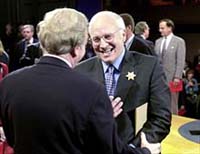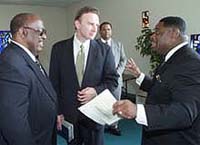
| Headlines |
| Davis Op-Ed |
| week of: |
| Sept. 27th |
| Oct. 4th |
| Oct. 11th |
| Oct. 18th |
| Oct. 25th |
| Nov. 1st |
| Nov. 8th |
| Nov. 15th |
|
Five
Women Discuss the Candidates |
|
||
|
|
Continuing
to Battle for Florida's Electoral Votes Florida has the largest block of electoral votes -25 -that is considered still up for grabs. It is no surprise that both Bush and Gore spent time courting Florida's voters this past weekend. Read what the Washington Post and Los Angeles Times had to say about the campaign in Florida. Source: The Washington Post |
||
|
Heated
Rhetoric as Candidates Return to Florida |
 With at least two polls conflicted about whether their debate had any effect on the race, Bush and Gore trade barbs as they stump in a key state |
||
 Dick Cheney, right, talking with Senator Joseph I. Lieberman on Thursday night after their debate at Centre College in Danville, Ky. |
Running
Mates, Ready to Fight, Kept Gloves On The day before his debate with Senator Joseph I. Lieberman in Danville, Ky., Dick Cheney said he hoped to set a "pleasant and professional tone" there. Nonetheless, he and his coaches made sure he went to the table armed with attack lines, just in case. Source: The New York Times |
||
| A
House Impeachment Manager Fights for Re-election Against the advice of his campaign advisors, Republican U.S. Rep. James E. Rogan won't stop talking about his prominent role in last year's impeachment trial of President Clinton. The two-term congressman from Glendale even had the idea for a poster that features a photograph of the 13 Republicans in the House of Representatives who served as prosecutors during the trial. Most are wearing somber expressions, but Rogan, standing in the center, is smiling. source: LA Times |
 U.S. Rep. James Rogan, above center, meets the Rev. Tyrone Skinner, right, and Deacon John Wright at Metropolitan Baptist Church in Altadena. |
||

debating the issues or the olympics of spin? |
A
British View of the First Presidential Debate Columnist Martin Kettle of The Guardian notes that "the debates are not so much a battle for the voters, as a battle to shape the media's message to the voters. They are, in fact, nothing less than the Olympics of spin." Read his full analysis here. Source: The Guardian |
||
| Abortion
Pill's Fate Is Linked to Election WASHINGTON--Although the issue has been lightly mentioned on the campaign trail, whoever wins next month's presidential election could play a significant role in whether and how U.S. women have access to RU-486, the abortion pill. Source: LA Times |
Bush's
Chief Advertising Strategist: A Former Democrat The architect of George W. BushÕs advertising strategy is Mark McKinnon, who used to work for Democrats such as Ann Richards, Bush's predecessor as Texas governor. The Los Angeles Times profiles McKinnon and what his shift of allegiance tells us about advertising and consultants in contemporary campaigns. source: LA Times |
||
|
Other Stories:
Op-Ed piece for the week of October 4th Election Analysis and Commentary Saturday, October 7, 2000 The estimated audience for the first debate between George W. Bush and Al Gore, broadcast last Tuesday night, was 46 million people. The estimated audience for the vice-presidential debate on Thursday night between Dick Cheney and Joe Lieberman was 28 million people. These numbers represent some of the lowest viewership for presidential campaign debates since 1976. In recent election cycles, presidential candidate debates have typically drawn 60 to 70 million viewers, and vice presidential debates 40 to 50 million viewers. Viewership for the conventions held this summer was also down from previous election years, and more respondents than in earlier election cycles have told pollsters that they have not been following the election campaign closely, or do not have a strong interest in the election results. This year's campaign, according to nearly all independent analysts, is the closest presidential campaign since the Kennedy-Nixon race of 1960. There are substantial differences between Gore and Bush on a large number of key domestic and foreign policy issues. Partisan control of both houses of Congress hangs in the balance. Why, with the race so close and the stakes so high, does interest in the campaign appear to be lower this year than in previous election cycles? One reason might be that the media have offered less campaign coverage to the voters in 2000. This summer, the big three networks offered no more than one hour of convention coverage per night. NBC gave its affiliates the choice of covering a baseball playoff game or the presidential debate on Tuesday night. All the stations on the Fox network showed baseball rather than the vice presidential candidates on Thursday night. Some executives at the major networks have justified these cutbacks in campaign coverage by saying that viewers who really want to see political news and events may do so on the all-news networks: CNN, MSNBC, and Fox News Channel. This argument is problematic on two grounds. First, not all households with televisions have access to the cable news channels, whereas the reach of ABC, CBS, and NBC is pervasive throughout the country. Second, by providing sports or entertainment alternatives to important campaign events such as debates, the major networks do less well in meeting their responsibility to serve the public interest. NBC chose to tape-delay its Olympics coverage. Could it not have tape-delayed Tuesday_s baseball game so that all NBC stations would have carried the presidential debate? Isn't it more important for all potential voters to have a chance to view George W. Bush and Al Gore live than to know immediately whether the Yankees or the A's won the first game of a playoff series? The decline in interest in the campaign should not be attributed solely to the media. More and more Americans see national politics as less relevant to their lives,thinking that matters affecting their jobs, their families, their schools, and their neighborhoods are determined far more by individuals, businesses, voluntary associations, and state and local governments than by Washington. Although most Americans believe the country is now headed in the right direction, many believe the credit for the economic success of the past few years belongs far more to business than to government. According to this view, who is elected president does not matter all that much, since the economy is apt to continue growing in the future as it has in the past. Such an interpretation does not take into account the substantial differences in economic policy, and the role of the government in the economy and society, that are being put forth on the campaign trail by Governor Bush and Vice President Gore. National economic and regulatory policies would be very different, depending on who wins this election. The results of the presidential election will effect family and neighborhood life, in many ways, over the next four years. Other Americans claim to be just too busy to follow politics. With more households made up of single parents with children and two-earner families (often working at different times of the day), with the after-school lives of children increasingly structured and organized, and with the number of Americans having to travel for business increasing every year _ for all of these reasons, people have less time in their days to read newspapers or watch political coverage on television. There are several implications of the declining interest in politics and public affairs that are worth noting. First, paid television advertising becomes an increasingly important source of information about candidates, their biographies, and their policies. Voters may learn more about those seeking office from the commercials than from the newspapers or the news shows. But the information presented in the commercials may not always be accurate, and is not presented in a context in which facts can be checked or assertions rebutted. Second, declining interest in politics may result in declining election turnout. Voter participation in presidential elections peaked in the modern era in 1960, when just over 60 percent of eligible voters went to the polls. Over the past forty years, presidential-year turnout has fallen to barely 50 percent of those eligible. Some analysts believe turnout this November might actually fall to as low as 48 percent of American citizens aged 18 and older. In comparison, turnout in national elections in European democracies routinely runs between 70 and 90 percent of those eligible to vote. Declines in turnout are not uniform across the population. Those who have intense views on political issues _ prescription drug benefits for the elderly, policies toward gun registration, or abortion _ turn out regardless of the overall level of participation. Those who may not be single- or multiple-issue advocates are more likely to be found among the non-voters. As the proportion of Americans going to the polls declines, the share of issue advocates among the electorate increases. One possible indication of turnout trends on November 7 will be viewership of the remaining two presidential debates. If viewership increases from the 46 million of the first debate, the predicted decline in voter turnout might not occur. But if the first debate turns out to have had the largest audience of the three, that does not bode well for a turnout of greater than 50 percent in November.
|
|||
|
|
|||

